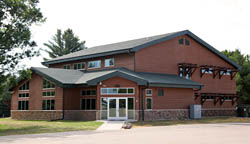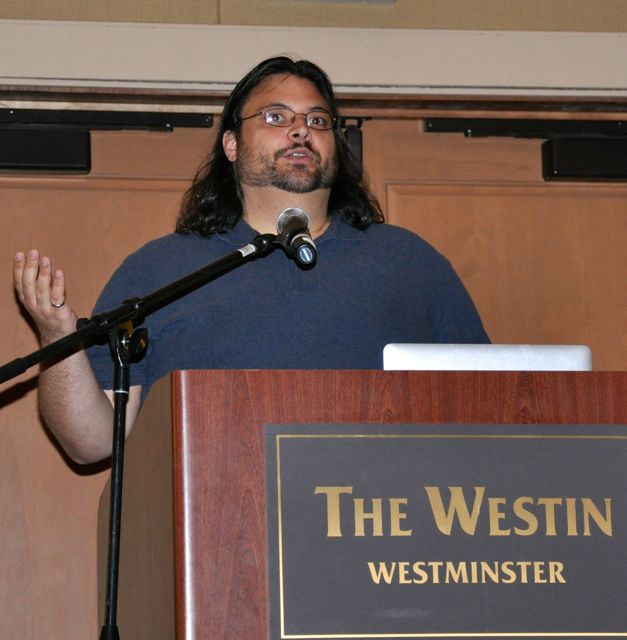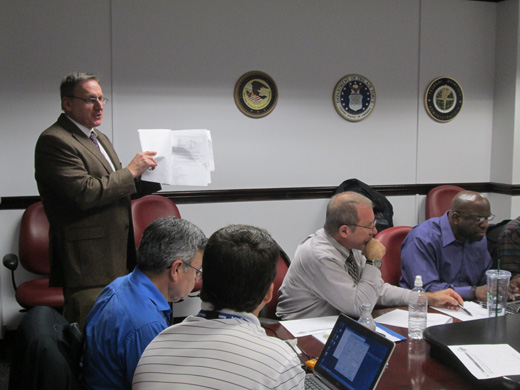NTIA Blog
Spotlight on NTIA: Mike Dame, Program Director, State and Local Implementation Grant Program
This post is part of our “Spotlight on NTIA” blog series, which is highlighting the work that NTIA employees are doing to advance NTIA’s mission of promoting broadband adoption, finding spectrum to meet the growing demand for wireless technologies, and ensuring the Internet remains an engine for innovation and economic growth.
 It’s not surprising that Mike Dame ended up working for the federal government on issues that ultimately will assist emergency first responders.
It’s not surprising that Mike Dame ended up working for the federal government on issues that ultimately will assist emergency first responders.
Dame, program director for NTIA’s State and Local Implementation Grant Program (SLIGP), grew up in the Washington area and his father worked for the Federal Aviation Administration. Dame had long planned to follow his Dad into public service, but had his hopes set on working for the FBI, the Bureau of Alcohol, Tobacco, Firearms and Explosives (ATF) or some other federal law enforcement agency.
Poor vision, however, derailed his plans for a federal law enforcement career so instead he switched his college major to a focus on government and politics. Despite this, Dame has still found ways to work on issues important to law enforcement while also fulfilling his desire for public service.
NTIA Grant Program Ensuring States are Planning for FirstNet
When Congress called for the creation of a nationwide broadband network for public safety in the Middle Class Tax Relief and Job Creation Act of 2012, lawmakers knew it was important that states play a key role in ensuring that the network meets the needs of local first responders. To implement this goal, the law directed NTIA to establish the State and Local Implementation Grant Program (SLIGP) to support states as they prepare for the launch of the network.
Since awarding grants to 54 states and territories in 2013, NTIA staff has been busy working with our SLIGP grantees on how to make the most of this opportunity. The $116 million in grants are helping states as they conduct outreach with public safety and state and local officials to determine their needs, gaps and priorities for public safety wireless broadband and to prepare for formal consultations with the First Responder Network Authority (FirstNet), which is developing the public safety broadband network.
As we continue to monitor the progress of these efforts, NTIA’s SLIGP federal program officers are conducting site visits to its state grantees. We are gaining valuable information from these visits about how different states are using their grants to plan for FirstNet and have begun sharing some of this information by developing best practices documents.
Operational Excellence in Federal Spectrum Management
This blog was cross posted on the Commerce.gov website.
One of the core functions of the National Telecommunications and Information Administration (NTIA) is to manage federal uses of wireless spectrum to make the most efficient use of this precious resource. It’s complex, technical work performed by a team of resourceful engineers who labor behind the scenes to ensure that federal agencies have the radio spectrum they need to perform all sorts of mission-critical functions.
For instance, the Federal Aviation Administration relies on spectrum to safely navigate planes. The National Oceanic and Atmospheric Administration depends on spectrum to communicate with weather satellites tracking storms. And the Pentagon uses spectrum to operate everything from radar systems to weapons systems.
NTIA’s Office of Spectrum Management makes this possible. And while the office has performed this vital mission for years, it’s a task that is taking on added urgency and facing mounting pressure amid skyrocketing commercial-sector demand for spectrum to fuel the explosive growth of wireless broadband.
The wild popularity of iPhones, Android devices and other mobile gadgets of all sorts – which consumers are using to upload picture to Facebook, watch videos on YouTube and devour other multimedia content – is driving unprecedented demand for bandwidth for licensed and unlicensed commercial wireless services.
The Public Computer Center at the College of Menominee Nation, Wisconsin
 While Native American Heritage Month is celebrated just once a year in November, the National Telecommunications and Information Administration (NTIA) has been serving America’s Tribal Nations effectively for many years through its grant programs.
While Native American Heritage Month is celebrated just once a year in November, the National Telecommunications and Information Administration (NTIA) has been serving America’s Tribal Nations effectively for many years through its grant programs.
One such grant of $3.4 million was made in 2010 to the College of Menominee Nation (the College) through the Broadband Technology Opportunities Program (BTOP). This Public Computer Center (PCC) project included the construction of a new 10,000 square foot campus Technology Center and upgrades of broadband capacity to serve the more than 5,000 members of the Menominee Tribe, who live in one of Wisconsin’s more rural and economically disadvantaged areas. According to Ron Jurgens, Institutional Research Director for the college, the new facility continues to draw people from the reservation and neighboring counties to use the technology, pursue their educational goals, and take advantage of 100 megabit Internet service. In fact, the center is so popular that the county board voted to relocate the public library on the college campus.
Spotlight on NTIA: Joel Dumke, Electronics Engineer, Institute for Telecommunication Sciences
This post is part of our “Spotlight on NTIA” blog series, which is highlighting the work that NTIA employees are doing to advance NTIA’s mission of promoting broadband adoption, finding spectrum to meet the growing demand for wireless technologies, and ensuring the Internet remains an engine for innovation and economic growth.
 Joel Dumke works on cutting-edge research that may help emergency first responders to better use video to help save lives. Dumke, an electronics engineer at NTIA’s Institute for Telecommunication Sciences (ITS) in Boulder, Colo., leads a team that is developing requirements and minimum standards for video systems that can be used by public safety.
Joel Dumke works on cutting-edge research that may help emergency first responders to better use video to help save lives. Dumke, an electronics engineer at NTIA’s Institute for Telecommunication Sciences (ITS) in Boulder, Colo., leads a team that is developing requirements and minimum standards for video systems that can be used by public safety.
For example, he noted that firemen can learn a lot about what is burning in a fire by watching video and observing the color, speed and location of the smoke.
One of his team’s current projects is focused on finding the right compression levels for transmitting video. Because video can eat up a lot of bandwidth, Dumke’s team is looking for ways to compress video signals while still preserving the video quality. It’s a delicate balance. “If you don’t compress it enough it consumes too many resources and if you compress it too much it becomes useless,” he said. “It’s interesting to find the sweet spot where it works well.”
NTIA Training Helps Federal Spectrum Managers
Agencies across the federal government use spectrum to perform critical functions from predicting the weather to air traffic control. But they may not be as familiar with NTIA’s role in this process and how we ensure agencies have the airwaves they need to carry out critical missions for the American people.
NTIA manages the federal government's use of spectrum, ensuring that the United States’ domestic and international spectrum needs are met while making efficient use of this limited resource. As part of this effort, twice a year we offer training in the latest tools, techniques, trends and issues to federal spectrum managers to better meet the requirements of their job.

NTIA’s Edward Drocella meets with participants at the most recent spectrum training session. (click for large version)
Celebrating the Internet Every Day
Today we are celebrating International Internet Day, which marks the first message ever sent over the Internet 45 years ago. At NTIA, one of our main jobs every day is to maximize the societal benefits made possible by the Internet through policies and efforts that expand Internet availability and adoption.
To help us in this work, it is important to know how Americans are using and accessing the Internet. Earlier this month, NTIA released the latest installment of our Digital Nation report series, which measures American computer and Internet use. The latest data, which is based on a survey of 53,000 households collected for NTIA by the Census Bureau in October 2012, demonstrated not only how ingrained the Internet has become in Americans’ lives but that we are now a digital nation on the go. The report found:
Spotlight on NTIA: Lynn Chadwick, Federal Program Officer, State Broadband Initiative
This post is part of our “Spotlight on NTIA” blog series, which is highlighting the work that NTIA employees are doing to advance NTIA’s mission of promoting broadband adoption, finding spectrum to meet the growing demand for wireless technologies, and ensuring the Internet remains an engine for innovation and economic growth.
You could say Lynn Chadwick’s career has come full circle.
After spending the early part of her career in community radio, she found herself in 2001 once again working with community telecommunications – this time from the federal perspective when she began working at NTIA first in the Public Telecommunications Facilities Program (PTFP). Now, working as a federal program officer for NTIA’s State Broadband Initiative (SBI), Chadwick’s focus is on helping states use broadband technology to better compete in the digital economy and assist states in gathering data twice a year on the availability of broadband in their communities.

Chadwick is pictured while visiting an exhibition in
London of the English artist Lynn Chadwick.
NTIA Brings a Comprehensive Approach to Community Broadband
The National Telecommunications and Information Administration (NTIA) last week hosted the second in a series of stakeholder workshops as we launch a new initiative to leverage the success of our Recovery Act broadband grant programs and support communities nationwide seeking to build their broadband capacity.
Over the past five years, NTIA’s Broadband Technology Opportunities Program and State Broadband Initiative have invested more than $4 billion in network infrastructure, public computer centers, digital inclusion projects and broadband mapping. These programs have taught us that closing the digital divide is a multi-pronged challenge that demands a comprehensive, holistic approach.
Addressing existing gaps requires not only network availability and robust bandwidth, but also affordable computer equipment and monthly service, effective training and useful applications. It also requires collaboration among many stakeholders, including local, state and federal officials, community leaders, industry executives, private foundations and broadband advocates.
Last week’s workshop, held in Minneapolis, brought together more than 100 stakeholders for a series of informative panel discussions, presentations and networking opportunities. Participants also met with NTIA staff, who will be providing guidance, technical assistance, funding leads and connections to help communities expand broadband access and adoption.
Spotlight on NTIA: Robert Denny, electronics engineer in the International Spectrum Policy Division, Office of Spectrum Management
This post is part of our “Spotlight on NTIA” blog series, which is highlighting the work that NTIA employees are doing to advance NTIA’s mission of promoting broadband adoption, finding spectrum to meet the growing demand for wireless technologies, and ensuring the Internet remains an engine for innovation and economic growth.
 Robert Denny was no stranger to NTIA when he finally decided to come to work here four months ago as an electronics engineer in the Office of Spectrum Management’s International Spectrum Policy Division.
Robert Denny was no stranger to NTIA when he finally decided to come to work here four months ago as an electronics engineer in the Office of Spectrum Management’s International Spectrum Policy Division.
Prior to joining NTIA, Denny spent three years at the National Oceanic and Atmospheric Administration’s National Weather Service, where he worked on many of the same issues he now deals with at NTIA.
Denny advocates for the U.S. position on issues related to international radio regulation at the International Telecommunication Union. But even before he came to the federal government, Denny’s work in the private sector aligned with many of NTIA’s issues.
